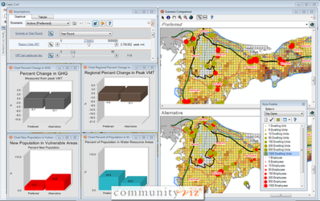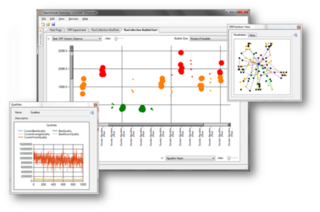Related Research Articles
In finance, technical analysis is an analysis methodology for analysing and forecasting the direction of prices through the study of past market data, primarily price and volume. As a type of active management, it stands in contradiction to much of modern portfolio theory. The efficacy of technical analysis is disputed by the efficient-market hypothesis, which states that stock market prices are essentially unpredictable, and research on whether technical analysis offers any benefit has produced mixed results. It is distinguished from fundamental analysis, which considers a company's financial statements, health, and the overall state of the market and economy.
The following outline is provided as an overview of and topical guide to software engineering:
TradeStation Group, Inc. is the parent company of online securities and futures brokerage firms and trading technology companies. It is headquartered in Plantation, Florida, and has offices in New York; Chicago; Richardson, Texas; London; Sydney; and Costa Rica. TradeStation is best known for the technical analysis software and electronic trading platform it provides to active traders and certain institutional trader markets. TradeStation Group was a Nasdaq GS-listed company from 1997 to 2011, until it was acquired by Monex Group, a Tokyo Stock Exchange-listed parent company of one of Japan's leading online securities brokerage firms.

In computing, a visual programming language, also known as diagrammatic programming, graphical programming or block coding, is a programming language that lets users create programs by manipulating program elements graphically rather than by specifying them textually. A VPL allows programming with visual expressions, spatial arrangements of text and graphic symbols, used either as elements of syntax or secondary notation. For example, many VPLs are based on the idea of "boxes and arrows", where boxes or other screen objects are treated as entities, connected by arrows, lines or arcs which represent relations. VPLs are generally the basis of Low-code development platforms.

Laboratory Virtual Instrument Engineering Workbench (LabVIEW) is a system-design platform and development environment for a visual programming language developed by National Instruments.
A GIS software program is a computer program to support the use of a geographic information system, providing the ability to create, store, manage, query, analyze, and visualize geographic data, that is, data representing phenomena for which location is important. The GIS software industry encompasses a broad range of commercial and open-source products that provide some or all of these capabilities within various information technology architectures.
In software engineering, profiling is a form of dynamic program analysis that measures, for example, the space (memory) or time complexity of a program, the usage of particular instructions, or the frequency and duration of function calls. Most commonly, profiling information serves to aid program optimization, and more specifically, performance engineering.
The Apple Developer Tools are a suite of software tools from Apple to aid in making software dynamic titles for the macOS and iOS platforms. The developer tools were formerly included on macOS install media, but are now exclusively distributed over the Internet. As of macOS 10.12, Xcode is available as a free download from the Mac App Store.
Omnis Studio is a rapid application development (RAD) tool that allows programmers and application developers to create enterprise, web, and mobile applications for Windows, Linux, and macOS personal computers and servers across all business sectors.

In software engineering, structured analysis (SA) and structured design (SD) are methods for analyzing business requirements and developing specifications for converting practices into computer programs, hardware configurations, and related manual procedures.

CommunityViz is the name of a group of extensions to ArcGIS Geographic Information System software. CommunityViz is an analysis tool used for, among other applications, urban planning, land use planning, geodesign, transportation planning and resource management applications. It also provides options for 3D visualization in the Scenario 3D and Scenario 360 plugins. CommunityViz also allows users to export and view their work in ArcGIS Online, Google Earth and other KML/KMZ viewers such as ArcGIS Explorer. The software was originally produced by the Orton Family Foundation and in 2005 was handed off to Placeways LLC. In 2017, the software was purchased by City Explained, Inc. where its development continues.
MultiCharts is a Windows-based application which is designed, sold and distributed by MultiCharts, LLC. The company is based in Columbus, Ohio, in the United States. MultiCharts is an electronic trading platform and technical analysis software for analyzing the financial markets and performing trade execution. It uses a proprietary programming language called PowerLanguage.
Microsoft SQL Server is a proprietary relational database management system developed by Microsoft. As a database server, it is a software product with the primary function of storing and retrieving data as requested by other software applications—which may run either on the same computer or on another computer across a network. Microsoft markets at least a dozen different editions of Microsoft SQL Server, aimed at different audiences and for workloads ranging from small single-machine applications to large Internet-facing applications with many concurrent users.

MetaTrader 4, also known as MT4, is an electronic trading platform widely used by online retail foreign exchange speculative traders. It was developed by MetaQuotes Software and released in 2005. The software is licensed to foreign exchange brokers who provide the software to their clients. The software consists of both a client and server component. The server component is run by the broker and the client software is provided to the broker's customers, who use it to see live streaming prices and charts, to place orders, and to manage their accounts.

Ichimoku Kinko Hyo (IKH) (Japanese: 一目均衡表, Hepburn: Ichimoku Kinkō Hyō), usually shortened to "Ichimoku", is a technical analysis method that builds on candlestick charting to improve the accuracy of forecast price moves.
Walk forward optimization is a method used in finance to determine the optimal parameters for a trading strategy and to determine the robustness of the strategy. Walk Forward Analysis was created by Robert E. Pardo in 1992 and expanded in the second edition. Walk Forward Analysis is now widely considered the "gold standard" in trading strategy validation. The trading strategy is optimized with in-sample data for a time window in a data series. The remaining data is reserved for out of sample testing. A small portion of the reserved data following the in-sample data is tested and the results are recorded. The in-sample time window is shifted forward by the period covered by the out of sample test, and the process repeated. Lastly, all of the recorded results are used to assess the trading strategy.

HeuristicLab is a software environment for heuristic and evolutionary algorithms, developed by members of the Heuristic and Evolutionary Algorithm Laboratory (HEAL) at the University of Applied Sciences Upper Austria, in Hagenberg im Mühlkreis. HeuristicLab has a strong focus on providing a graphical user interface so that users are not required to have comprehensive programming skills to adjust and extend the algorithms for a particular problem. In HeuristicLab algorithms are represented as operator graphs and changing or rearranging operators can be done by drag-and-drop without actually writing code. The software thereby tries to shift algorithm development capability from the software engineer to the user and practitioner. Developers can still extend the functionality on code level and can use HeuristicLab's plug-in mechanism that allows them to integrate custom algorithms, solution representations or optimization problems.
Intel Advisor is a design assistance and analysis tool for SIMD vectorization, threading, memory use, and GPU offload optimization. The tool supports C, C++, Data Parallel C++ (DPC++), Fortran and Python languages. It is available on Windows and Linux operating systems in form of Standalone GUI tool, Microsoft Visual Studio plug-in or command line interface. It supports OpenMP. Intel Advisor user interface is also available on macOS.

In finance, MIDAS is an approach to technical analysis initiated in 1995 by the physicist and technical analyst Paul Levine, PhD, and subsequently developed by Andrew Coles, PhD, and David Hawkins in a series of articles and the book MIDAS Technical Analysis: A VWAP Approach to Trading and Investing in Today's Markets. Latterly, several important contributions to the project, including new MIDAS curves and indicators, have been made by Bob English, many of them published in the book.
References
- ↑ Finextra (23 June 2004). "Fidelity invests in Wealth-Lab Developer software".
- 1 2 3 4 Keener, Rob (1 December 2005), "Wealth-Lab Pro (Software Review)", Futures (Cedar Falls, Iowa) (Futures Magazine Group), pp. 58–59
- ↑ "WealthScript is a class library of charting and trading functions" (PDF).
- ↑ Altucher, James (2004), Trade Like a Hedge Fund, 20 Successful Uncorrelated Strategies & Techniques to Winning Profits, John Wiley & Sons, p. Xii, ISBN 0-471-48485-7
- 1 2 3 4 5 Peterson, Dennis. "Wealth-Lab Pro", Stocks & Commodities (June 2012), Vol:30:6, p.56-59
- ↑ Carter, John (2007), SFO Personal Investor Series, Online Trading, Wasendorf & Associates, Inc., p. 191, ISBN 978-1-934354-00-1
- ↑ Katsanos, Markos (2008), Intermarket Trading Strategies, (Chapter 10, Trading System Design, Optimization Methods), John Wiley & Sons, Inc., ISBN 978-0-470-75810-6
- ↑ Ishikaw, Masumi; Doya, Kenji; Miyamoto, Hiroyuki; Yamakawa, Takeshi (2008), Neural Information Processing, Part II, Springer Publishing, p. 480, ISBN 978-3-540-69159-4
- ↑ "Subscription Plans for Wealth-Lab 8 - WealthLab".
- ↑ "Wealth-Lab Launches v7 with a New Engine".
- ↑ Altucher, James (2004), Trade Like a Hedge Fund, 20 Successful Uncorrelated Strategies & Techniques to Winning Profits, John Wiley & Sons, Inc., p. Xii, ISBN 0-471-48485-7
- ↑ "WealthLab Concierge Support Services - WealthLab".
- ↑ "Extensions - Wealth Lab". www.wealth-lab.com.
- ↑ "Extensions API - Wealth Lab". www.wealth-lab.com.
- ↑ "Anatomy of a Wealth-Lab Strategy".
- ↑ "WealthLab Extensions page".
- ↑ "Advanced Features for backtesting and trading - WealthLab".
- ↑ "Wealth-Lab Change Log".